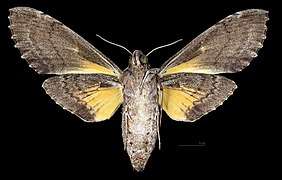Isognathus rimosa
Isognathus rimosa, the rimosus sphinx, is a moth of the family Sphingidae. The species was first described by Augustus Radcliffe Grote in 1865. It is known from tropical climates from northern Brazil north through Central America, the West Indies and Mexico to southern Arizona.[2]
| Rimosus sphinx | |
|---|---|
_Mexico_male.jpg) | |
| Scientific classification | |
| Kingdom: | |
| Phylum: | |
| Class: | |
| Order: | |
| Family: | |
| Genus: | |
| Species: | I. rimosa |
| Binomial name | |
| Isognathus rimosa | |
| Synonyms | |
| |
The wingspan is 70–102 mm. The upperside of the female forewing is mostly gray brown on the front half and dark brown on the rear half while the upperside of male forewing is yellow gray or gray brown. Both sexes have wavy dark markings. The upperside of the hindwing of both sexes is yellow with an incomplete dark border on the outer margin.
There are multiple generations per year in the tropics. In Arizona, adults have been recorded in August. They feed on flower nectar, including petunias.
The larvae have been recorded feeding on Plumeria rubra in Cuba and Plumeria alba, Plumeria obtusa and Plumeria rubra in Puerto Rico.
Subspecies
- Isognathus rimosa rimosa (northern Brazil north through Central America, the West Indies and Mexico to southern Arizona)
- Isognathus rimosa inclitus Edwards, 1887 (Mexico to Nicaragua)
- Isognathus rimosa jamaicensis Rothschild & Jordan, 1915 (Jamaica)
- Isognathus rimosa molitor Rothschild & Jordan, 1915 (Haiti)
- Isognathus rimosa papayae (Boisduval, 1875) (French Guiana and from Venezuela to Brazil)
- Isognathus rimosa wolcotti Clark, 1922 (Puerto Rico)
 Isognathus rimosa inclitus Female dorsal
Isognathus rimosa inclitus Female dorsal Isognathus rimosa inclitus Female ventral
Isognathus rimosa inclitus Female ventral
References
- "CATE Creating a Taxonomic eScience - Sphingidae". Cate-sphingidae.org. Archived from the original on 2012-11-11. Retrieved 2011-10-19.
- "Isognathus rimosa rimosa (Grote, 1865) Erinnyis rimosa". Silkmoths. 2011-05-14. Archived from the original on 2016-03-04. Retrieved 2011-10-19.
External links
| Wikimedia Commons has media related to Isognathus rimosus. |
- Lotts, Kelly & Naberhaus, Thomas (2017). "Rimosus sphinx Isognathus rimosa (Grote, 1865)". Butterflies and Moths of North America. Retrieved November 21, 2018.